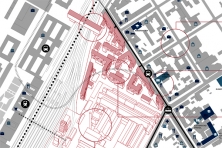FABLinz
Linz (AT) - Mentionné
DONNÉES DE L’ÉQUIPE
Représentant d’équipe: Andrea Chiarelli (IT) – architecte
Associés: Enrico Ferraresi (IT) – architecte ; Gabriella Dora Romito (IT) – architecte urbaniste; Giacomo Magnani (IT) – urbaniste
27 Luna House, 37 Bermondsey Wall West, SE16 4RN London (UK)
+44 740 087 1024 – info@sedicigradi.com – sedicigradi.com
Voir la liste complète des portraits ici
Voir la page du site en anglais ici

A. Chiarelli, G. D. Romito, E. Ferraresi & G. Magnani
INTERVIEW en anglais
Cliquer sur les images pour les agrandir
1. How did you form the team for the competition?
Three of us, Gabriella, Andrea and Enrico, collaborate under the name of Sedicigradi Atelier, working between London and Italy. Our paths crossed Giacomo's at the Bartlett School of Planning, UCL. We were all very much fascinated by E14 topic.
2. How do you define the main issue of your project, and how did you answer on this session main topic: the place of productive activities within the city?
Designing an open and adaptable system plays a crucial role in enabling a successful re-introduction of productive activities in the urban fabric. Thinking across scales and fields, from urban morphology to governance, was another key move for us. FABLINZ is both a new piece of city as well as an ecosystem of stakeholders. Its aim is to foster innovation by nurturing new collaborations and regenerating the neighbourhood. That is the core of FABLINZ, and that reflects in every part of it - from the management structure to the physical implementation. The relationships and the sharing are managed by a non-profit agency that allows a better coordination, identity creation and citizen participation. The scheme includes commercial, stores, housing, shared spaces, shared services, and everything you need to define a new neighbourhood as a piece of city, "within a resilient, welcoming and open urban space".
3. How did this issue and the questions raised by the site mutation meet?
FABLINZ offers a re-engineered version of the traditional productive block, found in the surrounding urban fabric. The new block offers a richer variety of spaces and opportunities for interaction. Housing, offices and retail seamlessly integrate productive activities and complete the on-site mix of uses. The urban morphology also responds to the need for phased development. To enhance the site's tremendous potential for regional connections, currently unexploited, we envisaged the Bridge Building, which will act as an anchor for the whole quarter.
4. Have you treated this issue previously? What were the reference projects that inspired yours?
Each of us has had the opportunity to work on different aspects of regeneration and productive cities across both academic and professional careers. With regard to the urban strategy, the regeneration of the Royal Docks in London has had some influence on our approach. We can also trace references to the Haussmanian building - regular and simple, adaptable to changes and different uses - and the unbuilt project for the Flaminio quarter in Rome by the Italian architecture office Labics and the Spanish architecture office Paredes Pedrosa Arquitectos.

5. Urban-architectural projects like the ones in Europan can only be implemented together with the actors through a negotiated process and in time. How did you consider this issue in your project?
The strategic approach we hypothesized, starts exactly from that consideration, taking time into account and designing a governance structure. Our proposal also identifies a whole spectrum of potential collaborations among stakeholders, while leaving it open to future negotiations which contractual shape the network of actors will eventually take.
6. Is it the first time you have been awarded a prize at Europan? How could this help you in your professional career?
Yes, this is the first time. We look forward to playing a role in the development of the site and to be involved in more multi-disciplinary urban regeneration projects. We believe that winning Europan is also a great opportunity for growing networks with other professionals, local governments and stakeholders in urban transformations across the EU. As European citizens, we strongly feel that building these cross-country relationships and knowledge exchange is crucial to positively evolve our cities and our society.





